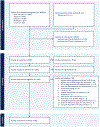Prevalence of Barrett's Esophagus and Esophageal Adenocarcinoma With and Without Gastroesophageal Reflux: A Systematic Review and Meta-analysis
- PMID: 37879525
- PMCID: PMC11039569
- DOI: 10.1016/j.cgh.2023.10.006
Prevalence of Barrett's Esophagus and Esophageal Adenocarcinoma With and Without Gastroesophageal Reflux: A Systematic Review and Meta-analysis
Abstract
Background and aims: Although gastroesophageal reflux disease (GERD) symptoms are an essential criterion for Barrett's esophagus (BE) screening in most gastroenterology society guidelines, a significant proportion of BE and esophageal adenocarcinoma (EAC) cases do not endorse them. In a systematic review and meta-analysis, we aimed to study the prevalence of BE/EAC in those with and without GERD.
Methods: A systematic search was conducted through 5 major databases for studies reporting prevalence of BE/EAC in patients with and without GERD. Pooled proportions and odds ratios (ORs) of BE, long-segment BE, short-segment BE, dysplasia, and EAC in patients with and without GERD were synthesized.
Results: Forty-three articles (12,883 patients with GERD; 51,350 patients without GERD) were included in the final analysis. BE prevalence was 7% (95% confidence interval [CI], 5.8%-8.5%) and 2.2% (95% CI, 1.6%-3%) among individuals with and without GERD, respectively. EAC prevalence was 0.6% (95% CI, 0.4%-1%) and 0.1% (95% CI, 0%-0.2%) in those with and without GERD, respectively. The overall risks for BE (OR, 2.91; 95% CI, 2.06-4.11) and long-segment BE (OR,4.17; 95% CI, 1.78-9.77) were higher in patients with GERD, but the risk for short-segment BE (OR, 1.77; 95% CI, 0.89-3.52) did not differ between the two groups. In 9 population-based high-quality studies (2244 patients with GERD; 3724 patients without GERD), BE prevalence in patients without GERD was 4.9% (95% CI, 2.6%-9%). BE prevalence was highest in North American studies (10.6% [GERD] and 4.8% [non-GERD]).
Conclusions: BE prevalence in those without GERD is substantial, particularly in large high-quality population-based studies. These data are important to factor in future BE/EAC early detection guidelines.
Keywords: Epidemiology; Esophageal Cancer; Esophageal Neoplasm; Gastroesophageal Reflux Complications.
Copyright © 2024 AGA Institute. Published by Elsevier Inc. All rights reserved.
Conflict of interest statement
- JBK: Research funding from Exact Sciences, Inventor of intellectual property licensed to Exact Sciences
- SS: Research funding from Pfizer, Janssen, and AbbVie, Received personal fees from Pfizer (for ad-hoc grant review)
- PGI: Research funding from Exact Sciences, Castle Biosciences, CDX Medical and Pentax Medical, Consultant for Exact Sciences, Castle Biosciences, CDX Medical and Pentax Medical
The remaining authors disclose no conflicts of interest.
Figures



References
-
- Coleman HG, Xie S-H, Lagergren J. The Epidemiology of Esophageal Adenocarcinoma. Gastroenterology 2018;154:390–405. - PubMed
Publication types
MeSH terms
Supplementary concepts
Grants and funding
LinkOut - more resources
Full Text Sources
Medical

